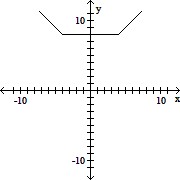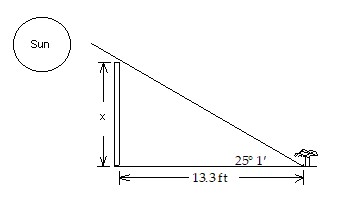Determine the intervals on which the function is increasing, decreasing, and constant.
A. Increasing on (-?, 4); Decreasing on (-4, ?); Constant on (4, ?)
B. Increasing on (4, ?); Decreasing on (-4, ?); Constant on (-4, 4)
C. Increasing on (-?, 4); Decreasing on (-?, -4); Constant on (4, ?)
D. Increasing on (4, ?); Decreasing on (-?, -4); Constant on (-4, 4)
Answer: D
You might also like to view...
Solve the problem.In one area, the lowest angle of elevation of the sun in winter is 25° 1'. A fence is to be built  away from a plant in the direction of the sun. (See drawing) Find the maximum height, x , for the fence so that the plant will get full sun. Round your answer to the tenths place when necessary.
away from a plant in the direction of the sun. (See drawing) Find the maximum height, x , for the fence so that the plant will get full sun. Round your answer to the tenths place when necessary.
A. 5.5 ft B. 6.2 ft C. 6.5 ft D. 7.7 ft
Solve the problem.In one state's Multi-Million Lottery you choose 5 numbers between 1 and 56 plus a Mega number between 1 and 36. Suppose that a winning ticket pays $60 million (assume that the prize will not be split among several winners). Find the expected value of a $1 lottery ticket. Round your answer to the nearest penny.
A. $-0.56 B. $-0.44 C. $-1.00 D. $0.44 E. $0.56
Use Gaussian elimination or Gauss-Jordan elimination to solve the problem.A company makes 3 types of cable. Cable A requires 3 black, 3 white, and 2 red wires. B requires 1 black, 2 white, and 1 red. C requires 2 black, 1 white, and 2 red. They used 95 black, 100 white and 80 red wires. How many of each cable were made?
A. 15 cable A 20 cable B 15 cable C B. 15 cable A 16 cable B 15 cable C C. 48 cable A 20 cable B 12 cable C D. 20 cable A 15 cable B 15 cable C
Solve the problem.A man rode a bicycle for 12 mi and then hiked an additional 8 mi. The total time for the trip was 5 hr. If his biking rate was 10 mph faster than his hiking rate, what was each rate?
A. Biking: 13 mph; hiking: 3 mph B. Biking: 11.5 mph; hiking: 1.5 mph C. Biking: 12 mph; hiking: 2 mph D. Biking: 14. mph; hiking: 4.5 mph